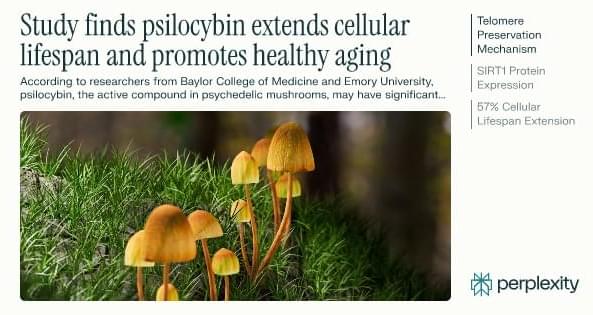Researchers found that psilocybin, from psychedelic mushrooms, extended cell lifespan and helped aging mice live longer and healthier.



According to researchers from Baylor College of Medicine and Emory University, psilocybin, the active compound in psychedelic mushrooms, may have significant anti-aging properties, extending human cell lifespan by up to 57% in laboratory studies and improving survival rates in aged mice by 30% compared to untreated controls.
Ray Kurzweil, the director of engineering at Google, has claimed that in just over 30 years, humans will be able to upload their entire minds to computers and become ‘digitally immortal’.

Scientists have discovered SB000, a single gene that reverses cellular aging by 13.6 years — matching or exceeding the rejuvenation power of the famous Yaman…

Exercise is extremely important, especially if we don’t move around much at work. There are plenty of apps and watches that can tell us when to move and be active. Primary care physicians emphasize exercise as a preventive measure against symptoms of aging. We are told that consistent exercise with a healthy diet is crucial for a high quality of life. As a result, we are all trying new diets and exercise routines to improve our health. Interestingly, there are specific regimens for individuals at different stages of life. Even cancer patients are encouraged to maintain as much of an active lifestyle as possible. However, how much does exercise really affect our health in cancer? Couldn’t we just each healthier?
A research group at the University of Pittsburgh discovered that exercise directly alters gut microbes which improve anticancer immunity. The paper published in Cell, by Dr. Marlies Meisel, Catherine Phelps, and others, demonstrated the mechanism that occurs in the gut after exercising. Meisel is an Assistant Professor in the Department of Immunology at the University at Pittsburgh. Catherine Phelps is a talented graduate student in the Meisel Lab and first author on the publication. Meisel’s research focuses on the mechanisms of the microbiota and its effect on systemic immunity. Specifically, she works to understand the role of the microbiome in the context of cancer and autoimmune disorders to improve therapeutic outcomes.
Previous work in the field demonstrated that exercise improves cancer therapy. Additionally, it was known that exercise changes the gut microbiome, which includes various bacteria that is helpful to the body. However, there was a gap missing between these two findings. Meisel and her team set out to understand how these two ideas were linked. Specifically, they wanted to know how exercise changes the gut microbiome to improve cancer immunotherapy. Catherine and other researchers in the Meisel Lab had mice exercise for four weeks in one group and had another group that did not exercise. When they implanted tumors, they found that the mice that exercised had smaller tumors compared to the no-exercise group. However, when researchers conducted the same experiment with mice that were germ-free or treated with antibiotics to eliminate the gut microbiome, they lost the change in tumor growth.

A blood-test analysis developed at Stanford Medicine can determine the “biological ages” of 11 separate organ systems in individuals’ bodies and predict the health consequences.
NASA’s Mars Reconnaissance Orbiter (MRO) is a long-running spacecraft mission dedicated to studying the Red Planet from orbit. Launched in 2005 and managed by NASA’s Jet Propulsion Laboratory (JPL) in Southern California for the agency’s Science Mission Directorate, MRO is part of NASA’s broader Mars Exploration Program. It plays a key role in analyzing Mars’ surface, atmosphere, and subsurface using a suite of advanced instruments.
One of MRO’s standout tools is SHARAD (Shallow Radar), which probes beneath the Martian surface to detect features like ice and rock layers. Provided by the Italian Space Agency and operated by Sapienza University of Rome, SHARAD is a collaborative effort analyzed by a joint U.S.-Italian science team, with U.S. participation led by the Planetary Science Institute in Tucson, Arizona.
Lockheed Martin Space, based in Denver, built the orbiter and continues to support its operations, ensuring the spacecraft’s longevity and scientific productivity well into its second decade.


What’s good for your aging gut may also be good for your aging brain. The first study of its kind in twins found that taking daily protein and prebiotic supplements can improve scores on memory tests in people over the age of 60.
Published early last year, the findings are food for thought, especially as the same visual memory and learning test is used to detect early signs of Alzheimer’s disease.
The double-blinded trial involved two cheap plant fiber prebiotics that are available over the counter in numerous nations around the world.